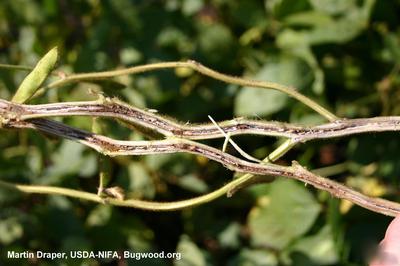Brown Stem Rot of Soybean
Cadophora gregata
Fungus
In a Nutshell
- Change of vascular and pith tissues from brown to reddish brown.
- Infect roots early in the season.
- Symptoms get worse between 17 and 27 C.
Can also be found in
Symptoms
Caused by Phialophora gregata, a fungus that survives in soybean residue. The pathogen infects soybean roots early in the season, but plants remain asymptomatic until pods begin to fill. Usually, vascular browning occurs along with leaf necrosis and chlorosis. In some cases, only internal vascular browning occurs.
Recommendations

Organic Control
Maintain a soil pH of 7 to reduce the risk of brown stem rot.

Chemical Control
Foliar fungicides have no effect on brown stem rot. Furthermore, seed treatment fungicides will also have no effect as just protecting the seedling won't be sufficient to inhibit infection after the materials have dissipated.
What caused it?
The pathogen of brown stem rot survives in soybean residue that was previously colonized during the pathogen's parasitic phase. The severity of the disease depends on the ambience, soil environments, and crop management systems. Stem and foliar symptoms are most severe when air temperatures range between 60 and 80 F.
Preventive Measures
- Adopt best management practices such as crop rotation, especially with the introduction of 2 to 3 years of non-host crops, spaced between soybean.
- Other approaches include variety selection and tillage are also proven effective.
- Use disease-resistant soybean varieties and cultivars only when high disease pressure is anticipated in an infested field.



